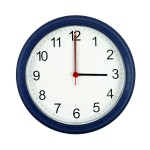Proving Praise Is Not Productive

This will improve your performance.
Here’s a little experiment for your next staff meeting. All you need is an open space about ten feet long and maybe three feet wide, two coins, and a flip chart.
Once you’ve cleared the space, set a target on the floor at one end of the ten-foot length. The target can be a trashcan, a book, a purse … anything to mark a fixed location on the floor.
On the flip chart, write down four categories:
- P+ — praise works; performance improves
- P- — praise doesn’t work; performance degrades.
- C+ — criticism works; performance improves
- C- — criticism doesn’t work; performance degrades
Now have one of your colleagues stand at the end of the ten-foot space farthest away from the target and facing away from it. Give her the two coins. Ask her to take one coin and throw it over her shoulder, trying to get it as close as possible to the target.
Observe where the coin lands. If it’s close to the target, praise your colleague lavishly: “That’s great. You’re obviously a natural at this. Keep up the good work.” If the coin falls far from the target, criticize her equally lavishly: “That was awful. You’re just lame at this. You better buck up.”
Now have your colleague throw the second coin and observe whether it’s closer or farther away from the target than the first coin. Now you have four conditions:
- You praised after the first coin and performance improved. The second coin was closer. Place a tick in the P+ category.
- You praised after the first coin and performance degraded. The second coin was farther away. Place a tick in the P- category.
- You criticized after the first coin and performance improved. The second coin was closer. Place a tick in the C+ category.
- You criticized after the first coin and performance degraded. The second coin was farther away. Place a tick in the P- category.
Now repeat the process with many colleagues and watch how the tick marks grow. If you’re like most groups, Category 3 (C+) will have the most marks. Conversely, Category 1 (P+) will have the fewest marks.
So, we’ve just proven that criticism is more effective than praise in improving performance, correct? Well, not really.
You may have noticed that throwing a coin over your shoulder is a fairly random act. If the first coin is close, it’s because of chance, not talent. You praise the talent but it’s really just luck. It’s quite likely – again because of chance – that the second coin will be farther away. It’s called regression toward the mean.
Conversely, if the first coin is far away, it’s because of chance. You criticize the poor effort but it’s really just luck. It’s quite likely that the second coin will be closer. Did performance improve? No – we just regressed toward the mean.
What does all this prove? What you tell your colleagues is not the only variable. A lot of other factors – including pure random chance – can influence their behavior. Don’t assume that your coaching is the most important influence.
However, when we do studies that control for other variables, praise is always shown to be more effective at improving performance than criticism. I’ll write more about this soon. Until then, don’t do anything random.
(Note: I adapted this example from Daniel Kahneman’s book, Thinking Fast and Slow. I think Kahneman may have adapted it from Edwards Deming’s experiment involving a fork and different colored balls.)
More Time

Budget this!
Last week, in Time – The Infinite Resource, I wrote about the “time culture” in your organization. If your organization is like most, you keep close track of how employees spend money and no track of how they spend their time. Yet, management gurus like Peter Drucker, say that time is our most precious resource. If you can’t manage your time, you can’t manage anything.
In my post, I outlined three (of five) time management techniques that McKinsey recommends to make organizations more productive and less stressful. The basic trick is to treat time as a corporate resource rather than an individual resource. In other words, we should treat time essentially the same way as we treat money.
Here are the other two time techniques from the McKinsey article.
Refine the master calendar — to identify things that you can stop doing, you first need to identify (to yourself and others) that you are doing them. This often means a master calendar for key individuals and meetings. In fact, meetings are some of the biggest time wasters. (See the Travis Rule). Make them do double duty. If executives travel to a meeting, ask them to schedule other activities at the same time. Perhaps they can visit customers or schedule personnel evaluations on the same trip. McKinsey also suggests categorizing your meetings. Are they for: 1) reporting; 2) collaboration and coordination; 3) managing performance through course corrections; 4) making decisions? (Not approving decisions, but actually making them). McKinsey reports that, in top performing organizations, executive spend some 50% of their meeting time in decision-making meetings and only 10% in reporting meetings. Less efficient organizations often over-schedule reporting meetings and under-schedule decision-making meetings. By wasting time that also increases stress.
Provide high-quality administrative support – how often have I seen companies lay off relatively inexpensive clerical workers and then ask expensive executives to pick up the task? Far too often. That reduces the time efficiency of your most costly employees and adds to their stress. In McKinsey’s study, 85% of executives who manage their time effectively also report that they have excellent administrative support. Only 7% of the poor time manager report that they have excellent support.
It’s also interesting to note how effective time managers spend their time. According to McKinsey, the best managers are alone 24% of the time. That doesn’t mean they’re not communicating — they could be on the phone or e-mail — but it does mean that they’re not in meetings. They also spend 17% of their time in meetings with customers or prospects and another 10% in meetings with external stakeholders. Taking the three activities together, they spend 51% of their time not in internal management meetings. If you’re trying to organize your time more effectively, that seems like a good number to shoot for.
When effective time managers communicate with others, their preferred method is face-to-face meetings. Indeed, such meetings account for 38% of their communication time. This was a revelation to me. I’ve always believed that meeting face-to-face is the most effective way to communicate. But I never thought of them as time savers. Perhaps because face-to-face meetings do provide richer, more nuanced communications, they also save time in the long run. With richer communications, you make fewer errors — and correcting errors is a huge time sink.